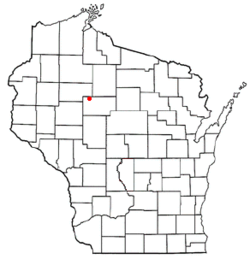Jump River (CDP), Wisconsin
| Jump River, Wisconsin | |
|---|---|
| Census-designated place | |

Fourth of July, with the Jump River town hall at back right.
|
|
 Location of Jump River, Wisconsin |
|
| Coordinates: 45°19′34″N 90°45′24″W / 45.32611°N 90.75667°W | |
| Country | United States |
| State | Wisconsin |
| County | Taylor |
| Area | |
| • Total | 0.372 sq mi (0.96 km2) |
| • Land | 0.372 sq mi (0.96 km2) |
| • Water | 0 sq mi (0 km2) |
| Elevation | 1,270 ft (387 m) |
| Population (2010) | |
| • Total | 52 |
| • Density | 140/sq mi (54/km2) |
| Time zone | Central (CST) (UTC-6) |
| • Summer (DST) | CDT (UTC-5) |
| Area code(s) | 715 & 534 |
| FIPS code | 55-38627 |
| GNIS feature ID | 1583460 |
Jump River is an unincorporated census-designated place located in the towns of Jump River and McKinley in Taylor County, Wisconsin, United States. It is located on the north bank of the Jump River, from which the hamlet takes its name. As of the 2010 census, its population was 52.
The first settlers in the Jump River area were Barney and Gertrude Broeder, who arrived in 1892 from Thorp, thirty miles to the south. They built a log home a mile upstream from the current village, at what is now called "the swimming hole." Starting in 1897 Barney ran a post office from his house under the name Broederville. Other settlers joined the Broeders in the area through the 1890s. A sawmill was added, a school was built nearby and in 1900 the "Black Bridge" was completed, crossing the river at Broederville. The remains of its concrete abutment can still be seen on the east bank above the swimming hole.
Until 1904, the settlers of Broederville reached the outside world by foot or horse through forest and swamp. The nearest contact with the outside was the railroad at Ingram, thirteen miles to the north. But in 1904 the Stanley, Merrill and Phillips Railway pushed up through the forest from Stanley to the south, crossing the Jump River where the town hall now stands. Within a few years, the businesses all moved a mile downstream to the railroad.
In 1907, the village of "Jump River" was platted at its current location, where the railroad crossed the river. The streets lay as they do now. The railroad had put up some buildings, including a depot. C.J. Boeckler built a hotel called the "Jump River House" and he moved his sawmill and post office from Broederville to the new town site. The Ladies' Aid Society built a hall which has been used over the years by the Catholics, the Presbyterians, the Lutherans, the Baptists, the VFW, Boy Scouts, 4-H, and for town meetings, elections, and many other purposes. More hotels and stores and sawmills were built, saloons and garages, a blacksmith shop, a feed store, a cheese factory, and shanties and houses. At times the town had a veterinarian, a dentist, a doctor, and a jeweler.
...
Wikipedia
